November 3, 2021
How to Stop an Electrical Fire
Expert Advice from an Electrician
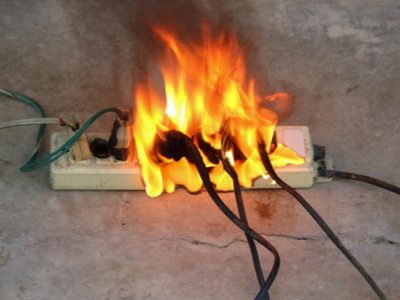

Too many devices and appliances plugged into one circuit can overload your home’s power supply. Ideally your circuit breaker will trip during a surge but in worst case scenarios, excessive live voltage can start an electrical fire.
As you add electricity consuming devices like frost-free refrigerators, clothes dryers, power tools and other appliances to your home, you risk inadequate power to supply them all. If you notice indicators like fuses or circuit breakers tripping, or lights dimming, it’s time to carefully look at your electrical system before you experience equipment failure or even a fire.
How do Electrical Fires Start?
Fire and electricity are dangerous forms of energy that create heat. Electricity converts to heat when it becomes ungrounded or uncontained. The two ways electricity can start a fire is via a spark or through overheating wires. This can happen from:
- Faulty/ loose wiring
- Undersized wires
- Frayed cords
- Old appliances
- Too many appliances drawing electricity on one circuit
- Inadequate distribution
When this undirected electricity combines with a combustible fuel source such as paper, wood or cloth, it turns into a flame.
5 Causes of Inadequate Power in Your Home
Let’s focus on how to stop an electrical fire by addressing the ways your home electrical supply might be inadequate for your needs.
- Limited service panel capacity
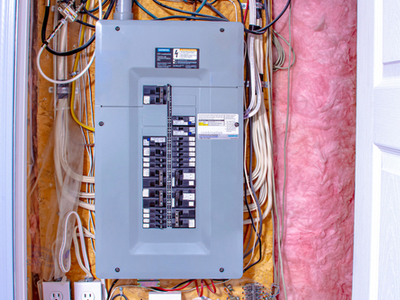

Your service panel is the metal box, often in your basement, that houses your circuit breakers. It’s where electricity enters your home from outside.
When the overall demand from total electrical devices in your home is greater than what your panel can supply, your service panel is likely to fail, frequently. Excess demand indicates that the panel rating is less than needed or that your panel might be limiting capacity because it has no space left for additional fuses or circuit breakers.
In either case it’s time to make a circuit map to calculate demand and compare it with the capacity of the main panel to supply. If you find the power demand is less than the capacity and there is no room for more breakers, then a sub-panel might be the answer. Conversely, if the overall demand is greater than the main panel ability to supply, then you will need a licensed electrician to install a new main service panel.
2. Overloaded circuits
Another use for the circuit map is to determine if demand on the circuits is greater than the amperage rating of the circuit controlling it. It’s important to note peak demands of appliances that may draw more power on starting and create a power surge that trips the breaker.
You can identify a power surge that doesn’t trip the breaker by lights dimming when an appliance turns on. Appliances that produce surges should have their own separate circuit designed to tolerate the surge.
To prevent the risk of fire, don’t exceed the safe amperage of any circuit. Blown fuses or tripped breakers indicate an overloaded circuit. Do not replace breakers with ones of higher amperage just because they fail. Instead, have a licensed electrician run a new circuit from the main panel that can supply the proper capacity.
3. Insufficient number of outlets
We recommend you have at least one outlet for every 12 feet of wall. Install ground fault interrupted outlets in bathrooms, kitchens and exterior walls as required by local codes.
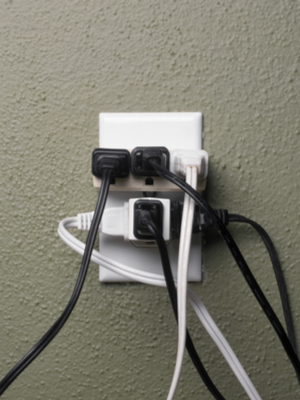

If you start to use multi-outlet extension cords on a regular or permanent basis, you probably need more outlets. Most low-cost extension cords are not designed to carry the heavy amperage demanded of permanent wiring. Excess loads traveling through extension cords may cause overheating and fire.
Computer workstations may require outlets for more than two devices from a single dual receptacle wall circuit. Your best solution is to supply the required outlets on separate circuits that are designed to exceed the demand.
Your next best option is to use a fused and surge protected uninterrupted power supply (UPS) to protect your equipment. UPS are now available for less than $100 and can protect your computer investment from power overloads. With less expensive power bars and extension cords, you run the risk of damaging your equipment or starting fires when the circuit becomes overloaded.
4. Inadequate feeder lines
Older houses may have original two-wire feed lines from the power company’s nearest utility pole. One of the wires is hot, delivering 110-115 volts, and the other is neutral.
These outdated lines will not power 240-volt appliances nor will their amperage likely be able to power more than a few newer appliances at a time. Your electric company should replace this two-wire system with a three-wire system at their own expense.
You will need electrician to install a new service panel to accommodate the change. Your electrician can use your circuit map and any expansion plans to determine future demand and size the new panel capacity accordingly.
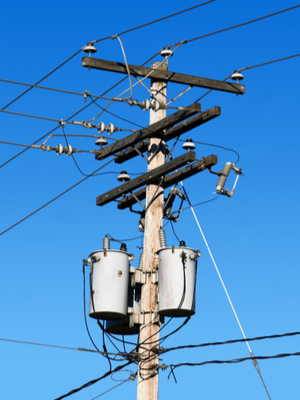

5. Overtaxed transformer
In older, high-density neighborhoods, electricity demands have increased. In some cases the transformer serving the area may not have been increased to meet this growth in demand. Although the power companies are required to scale up supply according to demand, you may want to check into the matter before paying to connect a larger service.
Consult with a trusted electrician from Applewood to assess your home’s electrical needs. One of our experts can determine if any of the above issues are a problem in your home and tell you how to prevent electrical fires from occurring with safe, updated wiring.
What does an Electrical Fire Smell Like?
Many signs of fire are invisible or inside your walls. The best way to detect an electrical fire is by the distinct odor. If you smell burning plastic, it may be the insulation from wiring overheating and melting.
Some people report a “fishy” smell before an electrical fire. This is caused by the heat resistant chemicals in wiring becoming too hot.
If you detect either electrical fire smell, investigate immediately for any signs of a fire and call 911 in the event of an emergency. Call your trusted Applewood plumber to diagnose any sources of electrical overheating.
How to Put out an Electrical Fire
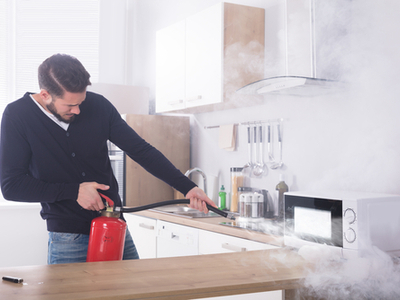

If you experience an electrical fire in your home or business, call 911 immediately. Fires can grow out-of-hand quickly. Make sure that you have at least two clear means of escape before you attempt to put out a fire.
To extinguish an electrical fire, follow these steps:
- Do NOT pour water on an electrical fire.
Water could cause shock or spread the fire.
- Disconnect the electricity.
Unplug whatever appliance started the fire. This will slow the fire from spreading to other areas. This may mean turning off all the power to your home at the electrical panel.
- Use a fire extinguisher
If you have one handy, a Class C fire extinguisher is your best and safest means of stopping an electrical fire. Stand back a safe distance and aim for the base of the fire.
- Pour baking soda on it.
Baking soda contains the same compound found in class C fire extinguishers. For smaller flames, it may do the trick.
- Smother it.
A fire blanket works well for electrical fire. It smothers the flame and denies it the oxygen it needs to burn. Only cover a fire if it’s smaller than your blanket.
- Wait for help.
Fire professionals are your best bet. Keep yourself and family safe until they arrive.
Keeping Denver and Boulder Homes Safe from Electrical Fires
Applewood has been keeping Colorado homes safely powered with expert electrical service for decades. We’ve seen power needs change and we’ve changed with them. Schedule your home electrical audit today or call us with any questions about your home’s electrical supply.


